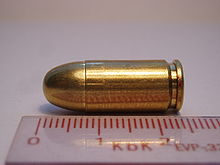.380 Auto
| .380 ACP | ||||||||||||||||||||||||
|---|---|---|---|---|---|---|---|---|---|---|---|---|---|---|---|---|---|---|---|---|---|---|---|---|

A .380 ACP pistol cartridge by Sellier & Bellot.
|
||||||||||||||||||||||||
| Type | Pistol | |||||||||||||||||||||||
| Place of origin | United States | |||||||||||||||||||||||
| Production history | ||||||||||||||||||||||||
| Designer | John Browning | |||||||||||||||||||||||
| Manufacturer | Colt's Manufacturing Company | |||||||||||||||||||||||
| Produced | 1908 | |||||||||||||||||||||||
| Specifications | ||||||||||||||||||||||||
| Case type | Rimless, straight | |||||||||||||||||||||||
| Bullet diameter | .355 in (9.0 mm) | |||||||||||||||||||||||
| Neck diameter | .373 in (9.5 mm) | |||||||||||||||||||||||
| Base diameter | .374 in (9.5 mm) | |||||||||||||||||||||||
| Rim diameter | .374 in (9.5 mm) | |||||||||||||||||||||||
| Rim thickness | .045 in (1.1 mm) | |||||||||||||||||||||||
| Case length | .680 in (17.3 mm) | |||||||||||||||||||||||
| Overall length | .984 in (25.0 mm) | |||||||||||||||||||||||
| Maximum pressure | 21,500 psi (148 MPa) | |||||||||||||||||||||||
| Ballistic performance | ||||||||||||||||||||||||
|
||||||||||||||||||||||||
|
Test barrel length: 3.75 inches (9.5 cm) Source(s): Federal Cartridge |
||||||||||||||||||||||||
The .380 ACP (9x17mm) (Automatic Colt Pistol) is a rimless, straight-walled pistol cartridge developed by firearms designer John Moses Browning. The cartridge headspaces on the mouth of the case. It was introduced in 1908 by Colt, for use in its new Colt Model 1908 pocket hammerless semi-automatic, and has been a popular self-defense cartridge ever since, seeing wide use in numerous handguns (typically smaller weapons). Other names for .380 ACP include .380 Auto, 9mm Browning, 9mm Corto, 9mm Kurz, 9mm Short, 9×17mm and 9 mm Browning Court (which is the C.I.P. designation). It is not to be confused with .38 ACP, 9mm Ultra, 9mm Makarov, 9mm Parabellum nor the rimmed .380 Long Revolver CF & .380 Rook Rifle cartridges, introduced around 1870.
The .380 ACP cartridge was derived from Browning's earlier 9×20mm semi-rimmed design, which was only marginally more powerful. The .380 ACP was designed to be truly rimless, with headspace on the case mouth instead of the rim for better accuracy. These relatively low-powered designs were intended for blowback pistols which lacked a barrel locking mechanism, which is often required for any handgun firing a round more powerful than a .380. Using blowback operation, the design can be simplified, and lowered in cost; a locking mechanism is unnecessary since the mass of the slide and strength of the recoil spring are enough to absorb the recoil energy of the round, due to the round's relatively low bolt thrust. Blowback operation also permits the barrel to be permanently fixed to the frame, which promotes accuracy, unlike a traditional short recoil-operation pistol, which requires a "tilting" barrel to unlock the slide and barrel assembly when cycling. A drawback of the blowback system is that it requires a certain amount of slide mass (weight) to counter the recoil of the round used. The higher the power the round, the heavier the slide assembly has to be in order for its inertia to safely absorb the recoil, meaning that a typical blowback pistol in a given caliber will be heavier than an equivalent recoil-operated weapon (alternatively, a very stiff spring will work, but will make operating the slide very difficult). Blowback weapons can be made in calibers larger than .380 ACP, but the required weight of slide and strength of spring makes this an unattractive option. Although the low power of the .380 ACP does not require a locking mechanism, there have also been a number of locked-breech pistols chambered in .380 ACP, such as the Remington Model 51, Kel-Tec P3AT and Glock 42; all three being designed to be lighter than blowback operated .380 ACP weapons. There have also been some relatively diminutive (blowback-operated) submachine guns, such as the Ingram MAC-11 and the Czech vz. 83.
...
Wikipedia
